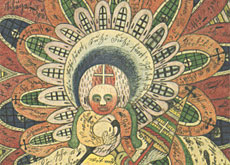New York recognises Switzerland’s Great Little Wolf

Actor Robin Williams and musician David Byrne from Talking Heads have one thing in common - a passion for the works of the late Swiss painter, Adolf Wölfli.
And their pictures are now on show in New York as part of a major exhibition of Wölfli’s genius at the American Folk Art Museum.
The show is part of a major eight-week festival in the Big Apple called “Swisspeaks”, which is to be a celebration of everything Swiss.
Wölfli has been described as arguably the greatest artist in the European tradition of art brut. The exhibition devoted to him features more than 100 stunning drawings and collages.
“Adolf Wölfli is a fascinating and magnificently accomplished artist,” said American Folk Museum director Gerard Wertkin.
The art of Wölfli goes under the majestic title: “St Adolf-Giant-Creation”.
“It’s the personal world of Adolf Wölfli, where he is at the centre and where he lives as St Adolf II as he calls himself,” Daniel Baumann, curator of the Adolf Wölfli Foundation at the Museum of Fine Arts in Bern, told swissinfo at the New York exhibition.
“It is a one person utopia, a world vision, a very personal one,” he added.
Radical it certainly is because Wölfli created his own world like no one else over a time span of 30 years, filling 25,000 pages with text, images, drawings, musical composition and complicated numbering systems.
Mental
However, Wölfli undertook his mammoth enterprise in anything but ideal conditions. He was confined to a mental hospital.
Born in 1864, he grew up in Bern in dire poverty during a time of great social crisis. His alcoholic father Jakob abandoned the family when Adolf was about five years old, and he and his mother Anna were forced to return to the village of Schangnau as wards of the community.
When she died in 1873, Adolf then only eight years old, continued the miserable life of a child hireling, working for a series of farming families, some of whom were abusive and negligent.
From 1880 to 1885, Wölfli worked as an itinerant farmhand and handyman. Falling in love with a neighbouring farmer’s daughter in 1882 was his undoing because the parents were against any match.
It was a loss that haunted him for the rest of his life, with his existence becoming more and more lonely.
Molestation
Beginning at the age of 26, he made three awkward and unsuccessful attempts to molest young girls. After some time in jail, he was committed to the Waldau Mental Asylum (now the Psychiatric University Clinic) in Bern.
The medical examiners at Waldau diagnosed schizophrenia and declared him “mentally incompetent”.
But after 1899, his mental state began to improve and he had begun to draw, although no works exist from these earliest years.
That art can survive is often luck or fortune. In Wölfli’s case, a young psychiatrist, Walter Morgenthaler, was instrumental in promoting the documentation of the artist’s work during his lifetime.
Morgenthaler encouraged Wölfli’s creative activity and published a comprehensive monograph on Wölfli’s life and art in 1921. Never before had a patient been called an artist.
Emotions
Does Wölfli have a message? “I don’t think it’s up to the artist to give us a message. We are giving the message to the work by looking at it, by thinking about it and by having our emotions,” curator Daniel Baumann told swisinfo.
“The first time you see a picture by him you think it’s like an avalanche of forms, of symbols, but then you start to understand the structure and you can orientate yourself within the picture,” he explained.
The Wölfli exhibition is on view at the American Folk Art Museum until May 18.
swissinfo, Robert Brookes in New York
Adolf Wölfli, the youngest of seven brothers, was born on February 29, 1864.
He excelled at school, completing his formal education in 1879.
He was declared “dangerous to society” in 1895 at the age of 31.
He remained at the Waldau Mental Asylum until his death on November 6, 1930, at the aged of 66.

In compliance with the JTI standards
More: SWI swissinfo.ch certified by the Journalism Trust Initiative










You can find an overview of ongoing debates with our journalists here . Please join us!
If you want to start a conversation about a topic raised in this article or want to report factual errors, email us at english@swissinfo.ch.